Russian cosmonaut Yuri Malenchenko is going ahead with his plans to marry his fianc? from space on August 10, despite protests from the Russian Aerospace Agency. Malenchenko will be represented at the wedding by a lawyer, and he’ll call in from the station during a special time when the astronauts are allowed to call their families. Astronaut Ed Lu quietly arranged to have his tailcoat and ring sent up on a recent Progress cargo ship.
NASA Picks the Next Mars Lander
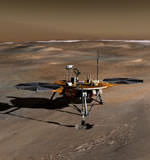
Image credit: NASA/JPL
NASA announced on Monday that it has selected the University of Arizona’s “Phoenix” mission to launch to Mars in 2007 as part of its new, low-cost Scout mission. NASA has granted the university $325 million to build the spacecraft, which will land on the planet’s northern pole, which is rich in water ice. The mission will have two goals: to study the geologic history of water, and to search for evidence of a habitable zone that may exist in the ice-soil boundary.
In May 2008, the progeny of two promising U.S. missions to Mars will deploy a lander to the water-ice-rich northern polar region, dig with a robotic arm into arctic terrain for clues on the history of water, and search for environments suitable for microbes.
NASA today announced that it has selected the University of Arizona “Phoenix” mission for launch in 2007 as what is hoped will be the first in a new line of smaller competed “Scout” missions in the agency’s Mars Exploration Program.
Dr. Peter H. Smith of the University of Arizona Lunar and Planetary Laboratory heads the Phoenix mission, named for the mythological bird that is repeatedly reborn of ashes. The $325 million NASA award is more than six times larger than any other single research grant in University of Arizona history.
“The selection of Phoenix completes almost two years of intense competition with other institutions,” Smith said. “I am overjoyed that we can now begin the real work that will lead to a successful mission to Mars.”
Phoenix is a partnership of universities, NASA centers, and the aerospace industry. The science instruments and operations will be a University of Arizona responsibility. NASA’s Jet Propulsion Laboratory in Pasadena, Calif., will manage the project and provide mission design. Lockheed Martin Space Systems, Denver, will build and test the spacecraft. Canadian partners will provide the meteorological instrumentation, including an innovative laser-based sensor.
Phoenix has the scientific capability “to change our thinking about the origins of life on other worlds,” Smith said. “Even though the northern plains are thought to be too cold now for water to exist as a liquid, periodic variations in the martian orbit allow a warmer climate to develop every 50,000 years. During these periods the ice can melt, dormant organisms could come back to life, (if there are indeed any), and evolution can proceed. Our mission will verify whether the northern plains are indeed a last viable habitat on Mars.”
The lander for Phoenix was built and was being tested to fly as part of the 2001 Mars Surveyor Program, but the program was canceled after the Mars Polar Lander was lost upon landing near Mars’ south pole in December 1999. Since then, the 2001 lander has been stored in a clean room at Lockheed Martin in Denver, managed by NASA’s new Mars Exploration Program as a flight asset.
Renamed Phoenix, it will carry improved versions of University of Arizona panoramic cameras and volatiles-analysis instrument from the ill-fated Mars Polar Lander, as well as experiments that had been built for the 2001 Mars Surveyor Program, including a JPL trench-digging robot arm and a chemistry-microscopy instrument. The science payload also includes a descent imager and a suite of meteorological instruments.
The mission has two goals. One is to study the geologic history of water, the key to unlocking the story of past climate change. Two is to search for evidence of a habitable zone that may exist in the ice-soil boundary, the “biological paydirt.”
The Phoenix robotic arm will scoop up martian soil samples and deliver them for heating into tiny ovens of the volatiles-analysis instrument so team members can measure how much water vapor and carbon dioxide gas are given off, how much water ice the samples contain, and what minerals are present that may have formed during a wetter, warmer past climate. The instrument, called thermal evolved gas analyzer, will also measure any organic volatiles.
Using another instrument, researchers will examine soil particles as small as 16 microns across. They will measure electrical and thermal conductivity of soil particles using a probe on the robotic arm scoop. One of the most interesting experiments is the wet chemistry laboratory, Smith said.
“We plan to scoop up some soil, put it in a cell, add water, shake it up, and measure the impurities dissolved in the water that have leached out from the soil. This is important, because if the soil ever gets wet, we’ll know if microbes could survive. We’ll know if the wet soil is super acidic or alkaline and salty, or full of oxidants that can destroy life. We’ll test the environment that microbes might have had to live and grow in,” Smith said.
Information is available online about NASA’s Mars exploration at http://mars.jpl.nasa.gov and about Phoenix at http://phoenix.lpl.arizona.edu .
Original Source: NASA News Release
Three Gorges Dam Seen From Above
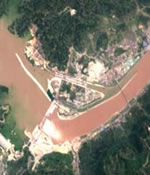
Image credit: ESA
China’s Three Gorges Dam was recently photographed from above by the European Space Agency’s CHRIS instrument on the Proba satellite. Since the sluice gates were closed in June, the water levels have risen 135 metres, and the dam will begin generating its first commercial electricity in August. More than 600,000 people were forced to abandon their homes, and the same number again will have to leave before the waters reach their planned 175 metre depth.
Water churns through diversion holes in the world?s largest dam – China?s Three Gorges project on the Yangtze River, imaged here by ESA?s Proba satellite this week. Seen to the left, the waters behind the dam have risen to a level of 135 metres since the sluice gates were first closed in early June, and in August Three Gorges is due to generate its first commercial hydroelectricity.
The Three Gorges project is set to create a new 600-km-long body of water on the face of the 21st century Earth: the thick concrete dam walls stand 190 metres tall and already they hold back an estimated 10 billion cubic metres of water. More than 600,000 people have had to abandon their homes to the rising reservoir, and as many again will have to relocate before the waters reach their final planned level of 175 metres.
Water flows through dam diversion holes
It can be clearly seen in the image how the river has burst its banks and is inundating the land upriver of the dam. The waters of the world?s third-longest river appear brown in colour because they are heavy with sediment.
Many environmentalists have campaigned against the ?20 billion-plus Three Gorges project due to the drowning of multiple cultural heritage sites, the fear that reservoir will collect industrial pollution and sewage that cannot now be washed to the sea, and the risk posed to downstream populations if the dam should ever break. But the Chinese government says the project will tame the flood-prone Yangtze River and generate much-needed electricity for economic development.
This 18-metre resolution image was acquired by the CHRIS sensor onboard Proba on 30 July 2003.
About Proba
Proba (Project for On Board Autonomy) is a micro-satellite the size of a small box, launched by ESA in October 2001 and operated from ESA’s Redu Ground Station (Belgium). Orbiting 600 km above the Earth?s surface, Proba was designed to be a one-year technology demonstration mission but has since had its lifetime extended as an Earth Observation mission. It now routinely provides scientists with detailed environmental images thanks to CHRIS – a Compact High Resolution Imaging Spectrometer developed by UK-based Sira Electro-Optics Ltd – the main payload on the 100 kg spacecraft.
Proba boasts an ?intelligent? payload, has the ability to observe the same spot on Earth from a number of different angles and can record images of an 18.6 km square area to a resolution of 18 m. More than 60 scientific teams across Europe are making use of Proba data. A follow-on mission, Proba-2, is due to be deployed by ESA around 2005.
Original Source: ESA News Release
Searching For Life on Non-Earthlike Planets
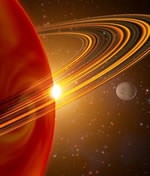
Image credit: NASA
A team of astronomers from Ohio State University believe that we should be seeking life on a wider range of planets than previously speculated. They calculated that NASA’s upcoming Space Interferometry Mission (SIM) should be able to detect habitable planets near stars which are much larger than the Sun. This opens up a whole new range of planets to look at. SIM was originally supposed to launch in 2009, but NASA is considering whether to use these funds to maintain Hubble past 2010 instead.
The search for life on other planets could soon extend to solar systems that are very different from our own, according to a new study by an Ohio State University astronomer and his colleagues.
In fact, finding a terrestrial planet in such a solar system would offer unique scientific opportunities to test evolution, said Andrew Gould, professor of astronomy here.
In a recent issue of Astrophysical Journal Letters, he and his coauthors calculated that NASA?s upcoming Space Interferometry Mission (SIM) would be able to detect habitable planets near stars significantly more massive than the sun.
Scientists have typically thought that the search for life should focus on finding planets like Earth that orbit stars like the sun, but this new finding shows that ?the field is wide open,? Gould said.
?Here?s a type of solar system that we never thought to look at,? he added, ?but now we?ll have the tools to do it.?
Gould is on the science team that is helping to plan the SIM mission, and he is working to define the capabilities of the satellite.
The satellite was set to launch in 2009, but its fate is now uncertain. NASA is considering whether to divert funds to maintain the Hubble Space Telescope beyond its scheduled retirement in 2010, Gould explained, and he has been asked to address the issue for an assembly of astronomers in Washington D.C. on Thursday, July 31.
SIM would help astronomers find habitable planets, Gould said. The key is detecting planets that circle a star at just the right distance to maintain a supply of liquid water. The range of most promising orbits depends on the type of the star, and is called the ?habitable zone.?
The earth resides directly in the habitable zone for our solar system, some 93 million miles from the sun. The nearest planets, Venus and Mars, barely lie within the edges of the habitable zone.
Hotter, more massive stars have always been considered less likely to harbor life, though not because they would be too hot. Planets could still enjoy temperate climates, just at orbits farther away from the star.
The problem is one of time, not temperature, Gould said.
Hotter stars tend to ?burn out? faster — perhaps too fast for life to develop there.
Our sun is approximately 4.5 billion years old; in contrast, one of the stars examined in the study is 1.5 times more massive than the sun, and would probably only generate life-sustaining energy for about two billion years.
Given the billions of years required for evolution of life on earth, scientists could question whether life would stand a chance in a shorter-lived solar system.
?We have no idea how evolution would proceed on any planet other than our own,? Gould said. ?If we find a planet around a shorter-lived star, we may be able to test what would happen to evolution under those circumstances.?
SIM will use Interferometry — a technique that involves the interference of light waves — to very accurately measure the position of stars in the sky. The satellite would notice, for instance, if a point of light on the surface of the moon moved the width of a dime.
In the case of distant stars, SIM will pick up on the tiny wobble in the position of a star caused by the gravity of its orbiting planets.
That?s what will make SIM ideal for studying hotter, massive stars, Gould said. Planets that orbit far from a star — as the habitable planets around a hot star would have to do — create a larger wobble.
He and study coauthors Eric B. Ford of Princeton University and Debra A. Fischer of the University of California, Berkeley, determined that SIM is sensitive enough for the task.
Previously, Gould and Ohio State professor Darren DePoy and graduate student Joshua Pepper determined that another future NASA mission could be used to find habitable planets around very small stars, which are much more plentiful in the galaxy than stars like our sun.
That mission, the Kepler Mission, will detect planetary transits — events where planets pass in front of a star and block the star?s light from reaching earth. Transits of planets orbiting close to a star are easier to detect, and because these small stars are very dim, the habitable zone would also be very close to the star.
?The point is that the various methods for planet detection complement each other, and can be used to find habitable planets around a wide variety of stars,? Gould said.
NASA funded this research.
Original Source: OSU News Release
Local Galactic Dust is on the Rise
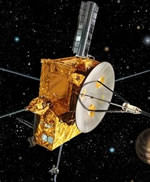
Image credit: ESA
New observations from the European Space Agency’s Ulysses spacecraft show that galactic dust in the Milky Way is passing through our solar system more than normal. The Sun’s magnetic field normally forms a barrier around our solar system that forces dust to go around us, but the Sun has reached the high point of its 11-year cycle, and the magnetic field is highly disordered – so the interstellar dust is coming through the solar system more directly. Although it has no direct effects on the planets, the dust impacts asteroids and comets producing more fragments, and may increase the amount of material that rains down on the Earth.
Since early 1992 Ulysses has been monitoring the stream of stardust flowing through our Solar System. The stardust is embedded in the local galactic cloud through which the Sun is moving at a speed of 26 kilometres every second. As a result of this relative motion, a single dust grain takes twenty years to traverse the Solar System. Observations by the DUST experiment on board Ulysses have shown that the stream of stardust is highly affected by the Sun’s magnetic field.
In the 1990s, this field, which is drawn out deep into space by the out-flowing solar wind, kept most of the stardust out. The most recent data, collected up to the end of 2002, shows that this magnetic shield has lost its protective power during the recent solar maximum. In an upcoming publication in the Journal of Geophysical Research ESA scientist Markus Landgraf and his co-workers from the Max-Planck-Institute in Heidelberg report that about three times more stardust is now able to enter the Solar System.
The reason for the weakening of the Sun’s magnetic shield is the increased solar activity, which leads to a highly disordered field configuration. In the mid-1990s, during the last solar minimum, the Sun’s magnetic field resembled a dipole field with well-defined magnetic poles (North positive, South negative), very much like the Earth. Unlike Earth, however, the Sun reverses its magnetic polarity every 11 years. The reversal always occurs during solar maximum. That’s when the magnetic field is highly disordered, allowing more interstellar dust to enter the Solar System. It is interesting to note that in the reversed configuration after the recent solar maximum (North negative, South positive), the interstellar dust is even channelled more efficiently towards the inner Solar System. So we can expect even more interstellar dust from 2005 onwards, once the changes become fully effective.
While grains of stardust are very small, about one hundredth the diameter of a human hair, they do not directly influence the planets of the Solar System. However, the dust particles move very fast, and produce large numbers of fragments when they impact asteroids or comets. It is therefore conceivable that an increase in the amount of interstellar dust in the Solar System will create more cosmic dust by collisions with asteroids and comets. We know from the measurements by high-flying aircraft that 40 000 tonnes dust from asteroids and comets enters the Earth’s atmosphere each year. It is possible that the increase of stardust in the Solar System will influence the amount of extraterrestrial material that rains down to Earth.
Original Source: ESA News Release
Largest Robotic Telescope Begins Operations
The Liverpool Telescope, the world’s largest robotic observatory, began operations this week. The 2-metre telescope is operated from Liverpool John Moores University, but it’s actually located in the Canary Islands, and run remotely. The telescope is especially suited to watching astronomical objects which change over time, such as Gamma Ray Bursts, supernovae, asteroids and comets. 5% of its time has been donated to the National Schools’ Observatory program, allowing school children to perform astronomy research.
Sea Launch Heads Out
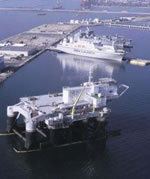
Image credit: Sea Launch
The Odyssey platform and Sea Launch Commander departed home port in California to make the journey down to the Earth’s equator in the Pacific Ocean. This time Sea Launch will loft the EchoStar IX/Telstar 13 broadcast satellite on board a Zenit-3SL rocket. The two-hour launch window is scheduled to begin on August 8 at 0331 GMT (11:31 pm EDT).
The Odyssey Launch Platform and the Sea Launch Commander have departed Sea Launch Home Port for the launch of the EchoStar IX/Telstar 13 satellite for EchoStar Communications Corporation and Loral Skynet. Liftoff is scheduled for August 7, in a two-hour launch window that will open at 8:31 pm PDT (3:31:00 GMT).
The Sea Launch vessels are sailing from Sea Launch Home Port, in the Port of Long Beach, Calif., to the launch site on the Equator at 154? West Longitude. Upon arrival, a 72-hour countdown will begin and the platform will be ballasted to launch depth. Over the course of the three-day countdown, the launch team will perform final tests on the rocket and spacecraft, and prepare for launch operations. The three-stage Zenit-3SL rocket will loft the 4,737 kg (10,443 lb) EchoStar IX/Telstar 13 satellite to a high perigee of 760 km in geosynchronous transfer orbit.
This is the first of several launch contracts Sea Launch will execute for Space Systems/Loral, the spacecraft manufacturer. The LS-1300-class satellite will be operational in its final position in geostationary orbit at 121? West Longitude. EchoStar?s Ku-band fixed satellite services (FSS) transponders are designed to enhance its U.S. DISH Network service. The spacecraft is also equipped with one of the first commercial Ka-band spot-beam payloads in the United States as well as a C-band payload.
In a unique satellite-sharing arrangement, EchoStar will own the Ku- and Ka-band payloads on this satellite. Loral Skynet, a subsidiary of Loral Space & Communications based in Bedminster, N.J., will own and operate the C-band capacity as Telstar 13. From its ideal orbital location and its 24 C-band transponders operating at 36 MHz, Telstar 13 will provide programmers with coverage of North America, including Alaska, Hawaii, Puerto Rico, Mexico and Central America.
Sea Launch Company, LLC, headquartered in Long Beach, Calif., is a world leader in providing heavy-lift commercial launch services. This multinational partnership offers the most direct and cost-effective route to geostationary orbit. With the advantage of a launch site on the Equator, the reliable Zenit-3SL rocket can lift a heavier spacecraft mass or provide longer life on orbit, offering best value plus schedule assurance. Sea Launch has a current backlog of 15 firm launch contracts. For additional information and live coverage of this mission, visit the Sea Launch website at: www.sea-launch.com
Note to editors: Sea Launch will carry a live satellite feed and streaming video of the entire mission on the day of launch. We will post transponder coordinates as well as additional information and high resolution images on a media site at: www.boeing.com/nosearch/sealaunch/
Original Source: Boeing News Release
What to Do With Hubble?
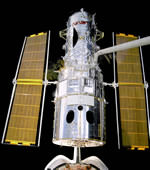
Image credit: NASA
The Hubble Space Telescope, one of the most important scientific instruments ever created, is entering the final chapter of its life, and NASA is trying to figure out what they should do with it. The Hubble Space Telescope was launched in 1990, and it’s expected to continue operations until 2010, when it’s replaced by the James Webb observatory which will launch in 2011. NASA has convened a special panel of experts to determine the best way to handle the transition.
The Hubble Space Telescope (HST) is one of the most important scientific facilities of NASA and indeed of the world. The HST has created enormous interest in astronomy and in space science, contributing in the process fundamental scientific discoveries related to the origins of the universe, the structure and evolution of the universe, and the exploration of the solar system. The scientific community has endorsed the James Webb Space Telescope as the next generation space telescope, the natural successor to the HST. It is a necessary task to consider exactly how and when to terminate the operation of this successful scientific experiment.
Currently, the end of Hubble operations is planned for 2010, and the launch of JWST is planned for late 2011. In principle, HST operations could be enhanced through continued servicing by the space shuttle. In fact, servicing may be essential to reach the 2010 target date. However, servicing missions by the shuttle are expensive and inherently dangerous.
NASA would like to assess the scientific impact of its current plan for effecting the transition from HST to JWST in the context of its overall space science program. In addition, NASA would like to determine if there are modifications to this plan that may better address key scientific issues within the constraints provided by the agency?s strategic plan and budget.
To this end NASA has chartered a panel of senior community members, with John Bahcall serving as chair, to review agency plans and to receive community input on the HST – JWST transition topic. The links below lead to the panel’s charter, membership roster, information about a public meeting on the topic and pages for people to provide the panel with their views via email. [Input closed August 13, 2003]
The final report from the HST-JWST Transition Panel may be found here.
Original Source: NASA Status Report
Solar Sail on Exhibit in New York
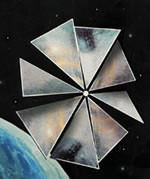
Image credit: Planetary Society
A full-sized replica of a Cosmos 1 solar sail is now on display at the Rockefeller Center “Centennial of Flight” exhibit in New York City. The 14.3 metre blade is made of a silvery Mylar-like material and joins several other exhibits at the show. If all goes well, the real solar sail will be launched on board a refurbished Russian ICBM some time this fall. The sail will be on display until August 18, 2003.
Planetary Society and Cosmos Studios will unfold a replica of one of the eight 47-foot blades that make up the Cosmos 1 Solar Sail spacecraft, which is slated to launch later this year. The silvery mylar-like blade will be on display in New York City as part of a large Rockefeller Center “Centennial of Flight” exhibit. The exhibit is from July 29 – August 18. Suspended from the soaring lobby ceiling, the blade will give the public their first-ever opportunity to see a technology that will likely fly missions throughout the solar system and to the stars.
A joint venture of The Planetary Society and Cosmos Studios, the Cosmos 1 Solar Sail is a visionary approach to space exploration. This is the first space mission ever conducted by a space interest group, and also the first by an entertainment media company.
“During the early 20th Century humanity found its wings above the sands of Kitty Hawk. Cosmos 1 represents the next centennial of flight, which will take us and our robotic emissaries from Earth to Mars, Pluto and beyond,” said Dr. Louis Friedman, Cosmos 1 Project Director and Executive Director of The Planetary Society.
“That a century after the Wright Bros.’ first flight, it is still possible for a small group of people with modest means to reach for the stars, is a good sign that the American dream remains vibrant,” said Ann Druyan, Cosmos 1 Program Director and CEO of Cosmos Studios. “Our launch vehicle, a Russian ICBM, has been converted from a weapon of mass destruction into a means of advancing the dream of exploring the universe. In this way, we hope to honor the inspiration of Carl Sagan and to give our kids a critically needed vision of a hopeful future.”
Solar sailing utilizes reflected light pressure pushing on giant panels, which adjust to the continuously changing orbital energy and spacecraft velocity. The sunlight pressure is powerful enough to push spacecraft between the planets. Beyond the solar system, space sailing can be done using powerful lasers focused over long distances in space. Solar sails might help us realize the long-sought dream of interstellar flight.
Other exhibits at the Centennial of Flight Anniversary will include a full-scale model of the Redstone Mercury rocket, a replica of Apollo 13, a model of the Wright Flyer, an X-43C (NASA’s prototype of the SCRAM JET engine), among other exhibits.
Cosmos 1 Solar Sail is a privately funded project with scientific and commercial applications that involve the cooperation of Russian space and defense organizations through a contract with The Planetary Society. The sail blade model being exhibited in part was developed by the Babakin Space Center near Moscow, Russia.
Babakin Space Center is the prime contractor for Cosmos 1. Babakin is a spin-off organization of NPO Lavochkin, one of the largest manufacturers of robotic spacecraft in the world. The Space Research Institute of the Russian Academy of Sciences and Makeev Rocket Design Bureau also play major roles in project development. Makeev is responsible for development of the Volna rocket – which will launch Cosmos 1 – and has made arrangements with the Russian Navy for the launch.
Original Source: Planetary Society News Release
Palomar Begins a New Sky Survey
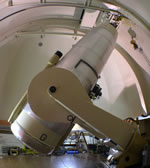
Image credit: Caltech
The Palomar Observatory has begun a new survey of the sky, and will explore the Universe from our solar system out to distant quasars, 10 billion light-years away. The survey will be done with the refurbished 48-inch Oschin telescope with a newly attached digital CCD camera – the largest ever built with 112 separate detectors. The researchers plan to publish images gathered by the telescope onto the web so that other astronomers can search the data for near-earth asteroids, Kuiper Belt objects, supernovae and other objects.
A major new sky survey has begun at the Palomar Observatory. The Palomar-QUEST survey, a collaborative venture between the California Institute of Technology, Yale University, the Jet Propulsion Laboratory, and Indiana University, will explore the universe from our solar system out to the most distant quasars, more than 10 billion light-years away.
The survey will be done using the newly refurbished 48-inch Oschin Telescope, originally used to produce major photographic sky atlases starting in 1950s. At its new technological heart is a very special, fully digital camera. The camera contains 112 digital imaging detectors, known as charge-coupled devices (CCDs). The largest astronomical camera until now has had 30 CCDs. CCDs are often used for digital imaging ranging from common snapshot cameras to sophisticated scientific instruments. Designed and built by scientists at Yale and Indiana Universities, the QUEST (Quasar Equatorial Survey Team) camera was recently installed on the Oschin Telescope. “We are excited by the new data we are starting to obtain from the Palomar Observatory with the new QUEST camera,” says Charles Baltay, Higgins Professor of Physics and Astronomy at Yale University. Baltay’s dream of building a large electronic camera that could capture the entire field of view of a wide-field telescope is now a reality. The survey will generate astronomical data at an unprecedented rate, about one terabyte per month; a terabyte is a million megabytes, an amount of information approximately equivalent to that contained in two million books. In two years, the survey will generate an amount of information about equal to that in the entire Library of Congress.
A major new feature of the Palomar-QUEST survey will be many repeated observations of the same portions of the sky, enabling researchers to find not only objects that move (like asteroids or comets), but also objects that vary in brightness, such as the supernova explosions, variable stars, quasars, or cosmic gamma-ray bursts–and to do this at an unprecedented scale.
“Previous sky surveys provided essentially digital snapshots of the sky”, says S. George Djorgovski, professor of astronomy at Caltech. “Now we are starting to make digital movies of the universe.” Djorgovski and his team, in collaboration with the Yale group, are also planning to use the survey to discover large numbers of very distant quasars–highly luminous objects believed to be powered by massive black holes in the centers of young galaxies–and to use them to probe the early stages of the universe.
Richard Ellis, Steele Professor of Astronomy and director of the Caltech Optical Observatories, will use QUEST in the search for exploding stars, known as supernovae. He and his team, in conjunction with the group from Yale, will use their observations of these exploding stars in an attempt to confirm or deny the recent finding that our universe is accelerating as it expands.
Shri Kulkarni, MacArthur Professor of Astronomy and Planetary Science at Caltech, studies gamma-ray bursts, the most energetic stellar explosions in the cosmos. They are short lived and unpredictable. When a gamma-ray burst is detected its exact location in the sky is uncertain. The automated Oschin Telescope, armed with the QUEST camera’s wide field of view, is poised and ready to pin down the exact location of these explosions, allowing astronomers to catch and study the fading glows of the gamma-ray bursts as they occur.
Closer to home, Caltech associate professor of planetary astronomy Mike Brown is looking for objects at the edge of our solar system, in the icy swarm known as the Kuiper Belt. Brown is convinced that there big objects out there, possibly as big as the planet Mars. He, in collaboration with astronomer David Rabinowitz of Yale, will use QUEST to look for them.
Steve Pravdo, project manager for the Jet Propulsion Laboratory’s Near-Earth Asteroid Tracking (NEAT) Project, will use QUEST to continue the NEAT search which began in 2001. The QUEST camera will extend the search for asteroids that might one day approach or even collide with our planet.
The Palomar-QUEST survey will undoubtedly enable many other kinds of scientific investigations in the years to come. The intent is to make all of the copious amounts of data publicly available in due time on the Web, as a part of the nascent National Virtual Observatory. Roy Williams, member of the professional staff of Caltech’s Center for Advanced Computing Research, is working on the National Virtual Observatory project, which will greatly increase the scientific impact of the data and ease its use for public and educational outreach as well.
The QUEST team members from Indiana University are Jim Musser, Stu Mufson, Kent Honeycutt, Mark Gebhard, and Brice Adams. Yale University’s team includes Charles Baltay, David Rabinowitz, Jeff Snyder, Nick Morgan, Nan Ellman, William Emmet, and Thomas Hurteau. The members from the California Institute of Technology are S. George Djorgovski, Richard Ellis, Ashish Mahabal, and Roy Williams. The Near-Earth Asteroid Tracking team from the Jet Propulsion Laboratory consists of Raymond Bambery, principal investigator, and coinvestigators Michael Hicks, Kenneth Lawrence, Daniel MacDonald, and Steven Pravdo.
Installation of the QUEST camera at the Palomar Observatory was overseen by Robert Brucato, Robert Thicksten, and Hal Petrie.
Original Source: Caltech News Release
